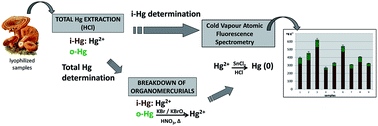Non-chromatographic speciation of mercury in mushrooms
Abstract
A fast, sensitive and cheap procedure has been developed for the determination of inorganic mercury (i-Hg) and organic mercury (o-Hg) in mushroom samples. The procedure is based on the use of cold vapour atomic fluorescence spectrometry (CV-AFS). The method involves the extraction of total mercury (t-Hg) with diluted HCl, followed by measurements of the corresponding Hg vapour under two different conditions: (i) directly to determine i-Hg, and (ii) after oxidation with a mixture KBr/KBrO3 to determine t-Hg. o-Hg was estimated from the difference between t-Hg and i-Hg. Previous studies were focused on the assessment of different reagents for mercury extraction and breakdown of organomercury compounds. The limit of detection values for the method were 3.2 ng g−1 for t-Hg and 0.6 ng g−1 for i-Hg, expressed in terms of sample dry weight. The mean relative standard deviation values in actual sample analysis were below 4%. The comparison of t-Hg data with results obtained through a reference direct mercury analyser evidenced the complete extraction of Hg species employing the developed method. Recovery studies provided percentages between 95 and 104% for all spiked samples, indicating that species interconversion was avoided under the selected experimental conditions. The results obtained for commercially available mushroom samples varied from 271 to 620 ng g−1 dry weight with 81–91% of i-Hg and 9–19% of o-Hg.


 Please wait while we load your content...
Please wait while we load your content...